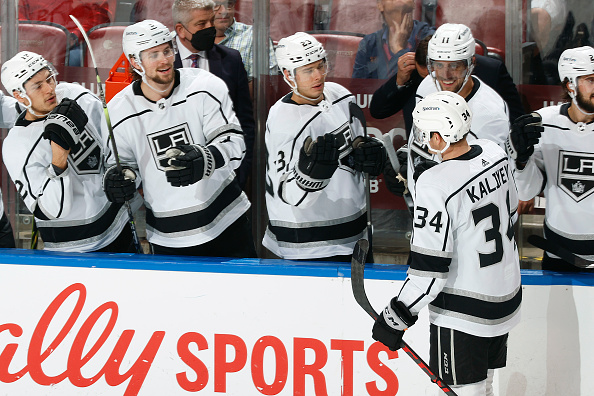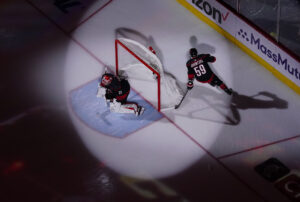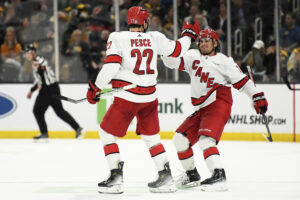The Los Angeles Kings power play currently sits 27th in the NHL, performing at an underwhelming 16.3 percent. As discussed in part one, the personnel they have been using has not been the right group of players. Additionally, though, both LA’s strategy and positioning of certain players have been poor as well.
How the Los Angeles Kings Power Play Can Be Fixed – Strategy
Along with having the wrong personnel on the ice for the power play, the very strategy the Kings have been using has not been effective and needs changing. This includes both the plays they have been making, as well as the positioning of certain players.
The Drop Pass
A common play seen in the NHL is the drop pass on the power play to enter the offensive zone. It’s a play that the Kings attempt for almost every zone entry on the man advantage. In theory, the play works like this: the forwards position themselves just in front of the attacking blue line, while one player manning the point stands at the top of his own blue line, and a trailer stands behind his own net. The player stationed at his own blue line will take the puck, skate it to about centre ice, then drop it back to the trailer. The trailer then has enough room and momentum to build speed and swiftly skate through the neutral zone, dodge opposing players, and then gain offensive zone entry for his team.
While the structure for this play can work, the Los Angeles Kings power play has struggled to execute it well. For starters, the play itself can be very dangerous. Any time a player is making a blind pass behind them, there is always risk involved. The person making the drop pass usually cannot see the trailer they are dropping it back to. This can result in two key issues. Each of which the Kings have run into several times this season.
Missed Passes
The first issue that can be run into is an inaccurate pass because as mentioned, the passer cannot see the trailer. Obviously, on a power play, time is of the essence. Thus, to kill time, penalty killers try to shoot the puck all the way down into the opposing team’s own end. So, if a team is using the drop pass play and the pass misses the trailer, it has nearly the same effect as a penalty killer clearing the puck. It sends the puck back into your own team’s zone, completely wasting valuable time. This proves to be incredibly inefficient, as the team will waste time having to retrieve the puck and re-attempt gaining zone entry rather than trying to create scoring chances.
Turnovers
Another major issue the drop pass play can result in is turnovers. When making a blind drop pass, it can be hard for the passer to gauge how far away the trailer is from them. Consequently, the pass can be too soft on occasion, resulting in forecheckers picking it off. This then allows the penalty-killing team to not only gain puck possession but also scoring chances. This has happened to the Kings a little too often. They have given up seven short-handed goals this year, the second-most in the NHL. Needless to say, Marco Sturm and the rest of the Kings coaching staff need to come up with a more time-efficient, less risky play to enter the zone on the power play.
Player Positioning
Another issue the Kings need to address on the man advantage is the positioning and usage of certain players. The coaches are not playing every player to their strengths, resulting in missed scoring opportunities. Specifically, the way the coaches use Arthur Kaliyev is not ideal. So far on the power play this year, Kaliyev has been positioned at the left point. A spot that is entirely wrong for him to be in.
Kaliyev is arguably the best shooter on the Kings roster, and he has an absolute missile of a one-timer. Just a few years ago, he was the most prolific goal scorer in the OHL. He scored 51 goals in his draft year in 2019, and then paced for 52 the year after. The way he did this was primarily by positioning himself on the right side of the ice, ideally at the top of the right face-off circle. Being a left-shot, the right side is Kaliyev’s one-timer side. With how good his one-timer is, there is absolutely no reason for him to be on the left, especially on the man advantage.
For the Kings to maximize Kaliyev’s skill set, they need to station him on the right side of the ice and have his unit revolve around setting him up for a one-timer. When a team has a player with the goal-scoring ability of Kaliyev, there is no reason for them not to exploit it as much as possible. Especially if their power play is struggling.
Final Verdict
So the best way Los Angeles’ power play line up would look like the following:
Top Unit: Viktor Arvidsson – Anze Kopitar – Alex Iafallo
Drew Doughty – Adrian Kempe
Second Unit: Andreas Athanasiou – Quinton Byfield – Arthur Kaliyev
Sean Durzi – Gabriel Vilardi
While the second unit is admittedly very young, at a certain point, skill needs to be prioritized over experience. The power play is an opportunity for the best offensive players to provide offence for their team. These units give the Kings the best way to allow that. If the first unit uses Iafallo to create traffic and Arvidsson, Doughty, and Kempe as one-time options, they should be able to produce a decent amount. Similarly, if the second unit centres itself around creating a passing lane to give Kaliyev a one-timer, it should also succeed.
It is important to note though, that the one-timer should not be forced. There are plenty of other skilled players on unit two, so if a passing lane to Kaliyev does not present itself, other players should take initiative to look for something else. While setting up Kaliyev would be the ideal play, if he is completely covered, it is ok to look elsewhere.
So, if the Kings coaching staff can find an alternative to the drop pass play to gain zone entry, combined with all of the other suggested changes, the Kings should see their power play percentage begin to increase.
Main Photo:






